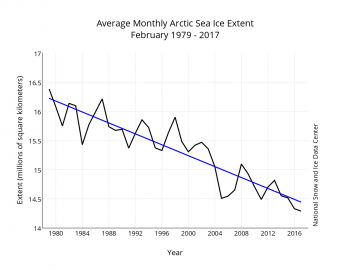If you have any trouble accessing any of these images, they are all in one place at:
http://nsidc.org/arcticseaicenews/
………………………………..
Arctic sea ice extent in the 2016/2017 (winter)
http://nsidc.org/arcticseaicenews/files/2017/03/asina_N_iqr_timeseries-350×280.png
………………………………..
February Arctic sea ice extent trend 1979-2016
http://nsidc.org/arcticseaicenews/files/2017/03/Figure3-350×270.png

…………………………………
Antarctic sea ice extent 2016/2017 (summer)
http://nsidc.org/arcticseaicenews/files/2017/03/asina_S_iqr_timeseries-350×280.png
…………………………………..
February Antarctic sea ice extent trend 1979-2016
http://nsidc.org/arcticseaicenews/files/2017/03/Figure4b-350×200.png
The good news is that this last graphic shows an overall slight increase in SIE over the last 38 years. The bad news is that the most recent data seems to be plunging down, and the data has become increasingly erratic, even chaotic, suggesting the S hemisphere system may be undergoing a fundamental change of state.
The NSIDC page linked also comments on the the possible interruption of satellite data we were discussing a few days ago.
As noted last year, the sensor that NSIDC had been using for sea ice extent, the Special Sensor Microwave Imager and Sounder (SSMIS) on the Defense Meteorological Satellite Program (DMSP) F17 satellite, started to malfunction. In response, NSIDC switched to the SSMIS on the newer F18 satellite. Later, F17 recovered to normal function, though it recently started to malfunction again.
The DMSP series of sensors have been a stalwart of the sea ice extent time series, providing a continuous record since 1987. Connecting this to data from the earlier Scanning Multichannel Microwave Radiometer (SMMR) results in a continuous record starting in 1979 of high quality and consistency. However, with the issues of F17 and last year’s loss of the newest sensor, F19, grave concerns have arisen about the long-term continuity of the passive microwave sea ice record. Only two DMSP sensors are currently fully capable for sea ice observations: F18 and the older F16; these two sensors have been operating for over 7 and 13 years respectively, well beyond their nominal 5-year lifetimes.
The only other similar sensor currently operating is the Japan Aerospace Exploration Agency (JAXA) Advanced Microwave Scanning Radiometer 2 (AMSR2), which is approaching its 5-year design lifetime in May 2017. NSIDC is now evaluating AMSR2 data for integration into the sea ice data record if needed. Future satellite missions with passive microwave sensors are either planned or proposed by the U.S., JAXA, and ESA, but it is unlikely that a successor to the DMSP series and AMSR2 will be operational before 2022. This presents a growing risk of a gap in the sea ice extent record.